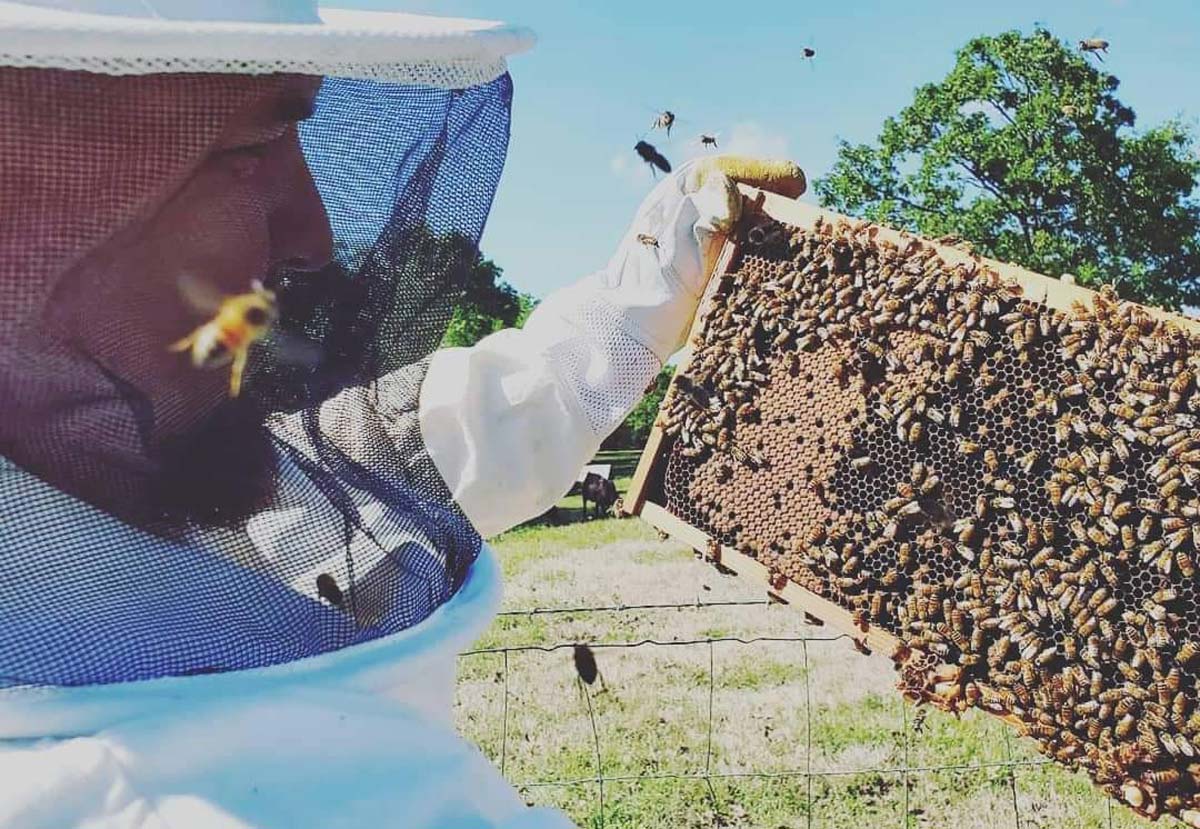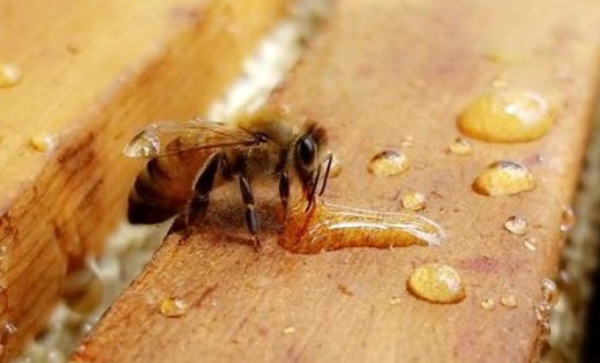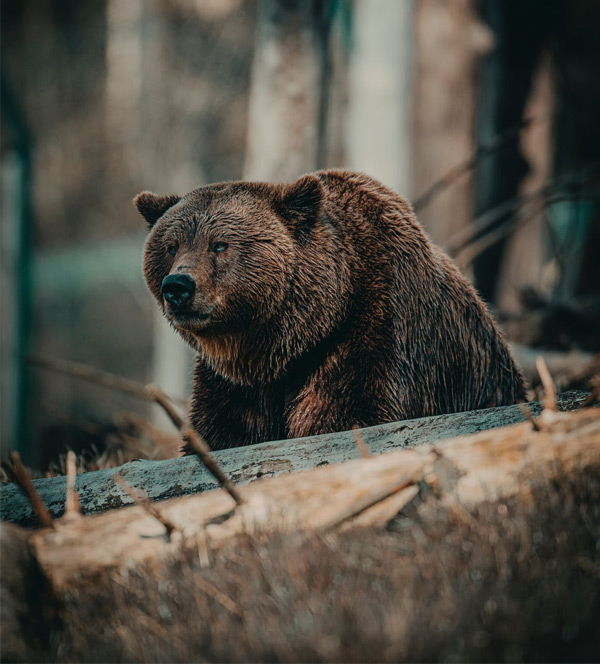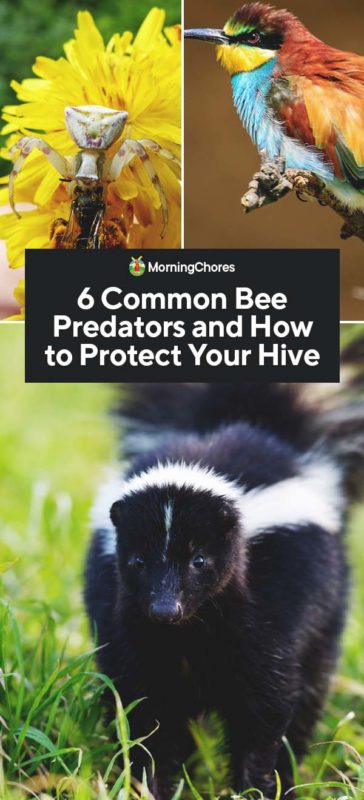
So you’ve taken up beekeeping and now you’re wondering how to keep those pesky pests and hungry predators away from your precious bees? Well, you’ve come to the right place! In this article, we’ll explore some effective ways you can protect your buzzing buddies from the challenges they face in their natural environment. From common pests like mites and beetles to larger threats like bears and birds, we’ve got you covered with practical tips and tricks to ensure the safety and well-being of your buzzing friends. Let’s get started and learn how you can create a secure and thriving bee sanctuary!
Identifying Pests and Predators
As a beekeeper, it is crucial to be able to identify common pests and predators that can pose a threat to your precious honeybees. By understanding their characteristics and behaviors, you can better protect your hives and ensure the health and productivity of your colony.
Understanding Common Pests
There are several types of pests that can wreak havoc on beehives. One of the most notorious is the Varroa mite, a parasitic mite that feeds on adult bees and their developing brood. These tiny mites can weaken the bees and transmit various diseases, ultimately leading to the overall decline of the colony if left untreated. Other common pests include wax moths, small hive beetles, and ants.
Recognizing the signs of infestation by these pests is crucial. Keep an eye out for abnormal behavior in your bees, such as increased aggression or weakened flying patterns. Look for visible signs of mite infestation, such as deformed wing virus or physical deformities on the bees themselves. Regular inspections and monitoring are key to catching these pests early and taking appropriate action.
Recognizing Predators in the Area
In addition to pests, predators can pose a significant threat to your bees. Animals such as bears, skunks, raccoons, and birds are known for their affinity for honey and bee larvae. These predators can wreak havoc on your hives, destroying frames and even killing the bees. It is essential to identify the predators in your area and take appropriate measures to deter them.
Keep an eye out for signs of predator activity, such as disturbed or damaged beehives, claw or bite marks, or the presence of animal tracks in the vicinity of your beekeeping area. It may be helpful to set up motion-activated cameras to capture evidence of predator visits, allowing you to take appropriate action or make necessary adjustments to your beekeeping setup.
Monitoring Beehive Activity
Regular monitoring of your beehives is crucial for identifying potential problems and taking appropriate action. Install observation hives or use window inserts in your existing hives to allow for easy visual inspection. During these inspections, pay close attention to the behavior of your bees, noting any changes or abnormalities.
Monitoring can also involve tracking the population size, honey production, and brood patterns of your colony. By keeping records and comparing them over time, you can spot trends or irregularities that could indicate pests or predators. Combining visual inspections with regular monitoring techniques will provide you with a comprehensive understanding of the health and activity of your bees.
Physical Barriers and Setups
Implementing physical barriers and setting up your beehives in a strategic manner can serve as an effective means of protecting your bees from pests and predators. By creating physical obstacles, you can deter unwanted intruders and ensure the safety of your colonies.
Installing Strong Fencing
One of the simplest yet effective ways to protect your beehives is by installing strong fencing around the perimeter. This acts as a deterrent for larger predators such as bears and can help prevent them from reaching your hives. Choose fencing materials that are sturdy and not easily penetrable. Electric fencing can also be an effective option, especially for deterring larger mammals.
When installing the fencing, ensure that it is at least six feet tall and extends at least one foot below ground level to prevent predators from digging underneath. Regularly inspect the fencing for any signs of damage or weakness and promptly address any issues to maintain its effectiveness.
Using Beehive Screens and Mesh
In addition to fencing, using beehive screens and mesh can provide an additional layer of protection for your hives. These screens are typically made of stainless steel or reinforced plastic and are designed to allow bees to enter and exit the hive while keeping larger pests out.
Install beehive screens on the entrance of your hives, effectively creating a barrier that prevents the entry of pests such as wax moths or small hive beetles. Ensure that the mesh size is small enough to keep out pests but still allows for adequate airflow. Regularly inspect these screens to remove any debris or blockages that may interfere with their effectiveness.
Constructing Protective Enclosures
For areas with high predator activity, constructing protective enclosures around your hives can provide an added layer of security. These enclosures can be constructed using various materials such as wood, metal, or even PVC pipes, depending on your preferences and resources.
The enclosure should cover the entire hive, including the top, sides, and bottom, leaving only the entrance accessible to the bees. Ensure that the material used is strong and durable, capable of withstanding any attempts by predators to access the hive. Regularly inspect these enclosures for any signs of damage or weakness and make any necessary repairs.

Natural Methods of Deterrence
Using natural methods of deterrence can be an environmentally friendly and effective way to protect your bees from pests and predators. By working with nature, you can create a balanced ecosystem that promotes the well-being of your bees while minimizing the risks posed by unwanted intruders.
Planting Bee-Friendly Herbs and Flowers
One of the most effective ways to deter pests and attract beneficial insects is by planting bee-friendly herbs and flowers around your beehives. Certain plants, such as lavender, rosemary, and marigolds, have natural repellent properties that can deter pests like wax moths and small hive beetles. Additionally, these plants attract beneficial insects such as ladybugs and lacewings, which feed on pests and help keep their populations in check.
Create a diverse garden with a variety of flowering plants to provide a continuous source of food for your bees and attract a wide array of beneficial insects. Incorporate plants that bloom at different times of the year to ensure a constant supply of nectar and pollen. Regularly maintain and water your garden to promote the health and vitality of the plants.
Attracting Beneficial Insects
Beneficial insects play a crucial role in maintaining a healthy ecosystem and can help control pests naturally. By creating favorable conditions for these insects, you can introduce a natural line of defense against pests that may threaten your bees.
One effective way to attract beneficial insects is by providing suitable habitats. Planting native wildflowers or creating areas of undisturbed vegetation can provide shelter and nesting sites for beneficial insects such as hoverflies and parasitic wasps. Avoid the use of pesticides that can harm these helpful creatures and disrupt the delicate balance of your ecosystem.
Installing Bat and Bird Boxes
Bats and birds are known for their pest-control abilities and can help keep populations of insects in check, including pests that may target your bees. By installing bat and bird boxes near your beehives, you can encourage these natural predators to establish a presence in your beekeeping area.
Bat boxes provide shelter for these nocturnal hunters, allowing them to roost during the day and venture out at night to prey on insects. Bird boxes create nesting opportunities for various bird species, many of which are voracious insectivores. Position the boxes strategically to provide optimal nesting conditions and ensure their safety from predators.
Chemical Control and Treatments
While natural methods of pest and predator control are ideal, there may be situations where chemical control and treatments become necessary. When used responsibly and as a last resort, specific chemical treatments can help mitigate immediate threats and protect your bees.
Applying Organic Pest Control Solutions
If natural methods and preventative measures fail to address pest infestations, consider using organic pest control solutions that pose minimal harm to your bees and the environment. Neem oil, for example, is a natural insecticide that repels and disrupts the life cycle of pests without harming beneficial insects.
Consult with local beekeeping associations or organic gardening experts to identify safe and effective organic pest control solutions that are suitable for your specific pest problems. Follow the instructions and recommended application rates carefully to minimize any potential risks.
Using Integrated Pest Management
Integrated Pest Management (IPM) is a holistic approach that combines various methods to manage pests effectively while minimizing the use of chemicals. By integrating cultural, physical, and biological control strategies, you can create a comprehensive pest management plan that is effective and environmentally friendly.
Implement cultural practices such as regular hive inspections and maintenance to identify issues early and ensure a healthy hive environment. Use physical barriers and traps to deter pests and capture them. Encourage beneficial insects and predators to establish a presence in your beekeeping area, and only consider chemical treatments as a last resort.
Avoiding Harmful Pesticides
When using chemical treatments, it is essential to avoid harmful pesticides that can pose a risk to your bees, the environment, and other beneficial insects. Certain pesticides, especially those in the neonicotinoid class, have been linked to serious harms to bees and other pollinators.
Always read and follow the label instructions of any pesticide products you use. Limit the application to times when bees are not actively foraging, usually in the early morning or late evening. Consider alternative treatments or consult with experts to find safer options that minimize the risks to your bees and the environment.

Nest Location and Hive Management
Proper nest location and hive management practices are essential for protecting your bees from pests and predators. By selecting well-protected nesting sites and maintaining hive hygiene, you can create a favorable environment that discourages unwanted intruders.
Selecting Well-Protected Nesting Sites
When choosing a location for your beehives, consider the surrounding environment and potential risks. Look for areas that provide natural protection from predators, such as dense vegetation or elevated spots. Avoid areas prone to flooding or strong winds that can negatively impact the stability and security of your hives.
Ensure that your hives are positioned off the ground, either on sturdy stands or elevated platforms. This not only helps protect them from pests that may crawl up from the ground but also improves hive ventilation and reduces the risk of moisture buildup.
Maintaining Hive Hygiene and Inspection
Regular hive inspections and proper hive hygiene are crucial for preventing and addressing pest and predator infestations. Be diligent in maintaining clean and well-organized hives, removing any debris, dead bees, or excess propolis. Inspect frames and comb regularly for signs of pest presence or damage.
During inspections, look for any signs of pests or predators, including abnormal behavior or visible indicators such as wax moth larvae or Varroa mite infestations. Take immediate action if signs of infestation are detected, deploying appropriate control methods or treatments to address the issue swiftly.
Providing Adequate Ventilation
Adequate ventilation is crucial for maintaining a healthy hive environment and discouraging pests and predators. Poor ventilation can lead to excess moisture buildup, creating favorable conditions for pests such as wax moths and molds.
Ensure that your hives are properly ventilated by providing adequate entrances, ensuring proper spacing between frames, and using ventilation aids such as screened bottom boards or top entrances. Regularly inspect your hives for signs of condensation or excess moisture and make adjustments accordingly.
Queen and Bee Genetics
The genetics of your bees play a significant role in their ability to resist pests and predators. By selecting and breeding bee strains with desirable traits, you can improve the overall resilience and vitality of your colonies.
Breeding Resistant Bee Strains
Consider breeding bee strains that exhibit resistance to common pests such as Varroa mites. Some honeybee breeds, such as Russian or Carniolan bees, have been found to possess genetic traits that make them more resistant to mite infestations. By selectively breeding from these colonies, you can introduce resistant genetics into your bee population.
Work with local bee breeders or beekeeping associations to source quality queen bees that exhibit genetic resilience to pests and predators. Monitor the performance and health of your colonies closely, selecting the strongest and most resistant bees for breeding purposes.
Introducing Predatory Mites
Predatory mites are a natural and effective means of controlling Varroa mite populations within your beehives. These tiny arachnids, such as the Stratiolaelaps scimitus mite, feed on the Varroa mites without harming the bees.
To introduce predatory mites, purchase them from reputable suppliers and follow the instructions provided. These mites can be added to beehives using special delivery methods, such as sugar and oil substrates, or by directly releasing them onto frames or combs. Regular monitoring and assessment are essential to evaluate the effectiveness of predatory mite populations and adjust as necessary.
Promoting Diverse Genetics
Maintaining a diverse genetic pool within your bee population is crucial for promoting overall health and resilience. Inbreeding can reduce the genetic variability of your colony, making them more susceptible to pests and diseases. Aim for genetic diversity by introducing different queen bees from various sources or by collaborating with other beekeepers for periodic queen exchanges.
Maintaining diverse genetics ensures that your bees possess a range of traits and characteristics that can contribute to their ability to resist pests and predators. It also aids in adapting to specific environmental conditions and promotes the long-term success and sustainability of your beekeeping operation.

Integrated Pest Management (IPM)
Integrated Pest Management (IPM) is a proactive approach to pest and predator control that aims to minimize reliance on chemical treatments while promoting long-term sustainability and healthy ecosystems.
Understanding IPM Principles
The foundation of IPM lies in understanding and utilizing multiple control strategies to manage pests and predators effectively. These strategies include cultural, physical, and biological controls, as well as the appropriate use of chemical treatments if necessary.
IPM emphasizes the creation of balanced ecosystems that favor the natural control of pests through natural predators and beneficial insects. This approach involves prevention, early detection, and monitoring to identify potential pest or predator issues before they become significant problems. By assessing the risks and considering the potential impacts of various control methods, beekeepers can make informed decisions and select the most appropriate strategies for their specific situations.
Implementing IPM Strategies
Implementing IPM strategies requires a proactive and holistic approach to pest and predator control. Regularly monitor your beehives for signs of pests or predators, regularly review hive conditions, and implement suitable prevention measures. Utilize physical barriers, traps, natural deterrents, and beneficial insect attractants to maintain a balanced ecosystem within your beekeeping area.
Consider the use of biological controls, such as introducing beneficial insects or predatory mites, to reduce pest populations naturally. Selective breeding and promoting diverse genetics within your bee population can also contribute to the overall resilience and success of your colonies.
Regular Monitoring and Record Keeping
Effective IPM relies on regular monitoring and record keeping to assess the success of pest and predator control strategies. Keep accurate records of hive inspections, pest observations, and any control measures implemented. This information will help you track trends and determine the effectiveness of specific methods.
Regularly review your records to identify patterns, areas for improvement, or potential risks. Adjust your IPM strategies accordingly, employing new tactics or modifying existing ones based on the information gathered. By continuously monitoring and documenting your beekeeping practices, you can refine your IPM approach and develop a customized pest and predator control plan that suits your specific needs.
Traps and Repellents
Traps and repellents can be valuable tools in your pest and predator control arsenal. By utilizing pheromone-based traps, sticky traps, and bee-friendly repellents, you can actively manage and control populations of pests or predator species that pose a threat to your bees.
Using Pheromone-Based Traps
Pheromone-based traps can be an effective way to lure and capture pests such as wax moths or small hive beetles. These traps utilize synthetic pheromones, which mimic the natural chemical signals emitted by pests to attract mates or locate food sources.
Place these traps strategically within your beehives or in areas of high pest activity. Follow the manufacturer’s instructions for proper placement, usage, and maintenance. Regularly inspect and clean the traps to ensure their effectiveness and prevent excessive buildup of captured pests.
Employing Sticky Traps
Sticky traps are another effective method for capturing pests and predators in your beekeeping area. These traps use adhesive surfaces to catch insects, preventing them from reaching your hives or causing damage.
Strategically place sticky traps at entrances, near known pests’ habitats, or within your hives. Ensure that the traps are securely fastened and positioned to avoid contact with your bees. Regularly monitor and replace these traps to maintain their efficacy and prevent overaccumulation of pests.
Utilizing Bee-Friendly Repellents
In situations where immediate protection is necessary, consider using bee-friendly repellents to deter pests and predators. These repellents utilize natural or synthetic compounds that pests find unappealing, effectively steering them away from your hives without harming your bees.
Carefully follow the instructions provided on the repellent product to ensure proper usage and application. Apply the repellent to barriers, entrances, or areas prone to pest activity. Regularly monitor the effectiveness of the repellent and reapply as needed.

Education and Collaboration
Engaging in education and collaboration within the beekeeping community is essential for staying informed, sharing knowledge, and exchanging experiences. By participating in beekeeping associations, attending workshops and conferences, and actively seeking out information, you can enhance your skills and learn from experienced beekeepers.
Participating in Beekeeping Associations
Beekeeping associations provide valuable resources and opportunities to connect with other passionate beekeepers. Joining a local association allows you to tap into a network of experienced beekeepers who can offer guidance, answer questions, and share insight into pest and predator control.
Participate in association meetings, events, or online forums to learn from others and exchange valuable information. Stay up to date with the latest research, best practices, and emerging pest and predator management techniques through association newsletters or publications.
Attending Workshops and Conferences
Attending workshops and conferences dedicated to beekeeping can broaden your knowledge in various aspects of the craft, including pest and predator control. These events often feature expert speakers, hands-on demonstrations, and opportunities to connect with other beekeepers.
Look for workshops or conferences that cover topics specific to pest and predator management. Attend sessions or join panel discussions that focus on integrated pest management, natural deterrents, or novel control strategies. Take advantage of these opportunities to learn from industry leaders and gain practical insights that you can apply in your own beekeeping practices.
Sharing Knowledge and Experiences
As an experienced beekeeper, sharing your knowledge and experiences can contribute to the collective learning and advancement of the beekeeping community. Share your successes and challenges, discuss pest and predator control techniques, and offer guidance to fellow beekeepers.
Participate in online forums, write articles for beekeeping publications, or organize local workshops or demonstrations to share your expertise. By actively engaging in knowledge-sharing and collaborating with other enthusiasts, you can help build a supportive and informed beekeeping community dedicated to the well-being of bees.
Early Detection and Control
Early detection and prompt action are crucial for effectively managing pests and predators in your beekeeping operation. A proactive approach to inspection, quarantine measures, and targeted treatment can prevent the escalation of infestations and minimize the impact on your bees.
Regularly Inspecting Beehives
Regular hive inspections are the frontline defense against potential pest and predator infestations. Schedule routine inspections to assess the overall health of your bees and identify any signs of pest presence or abnormal behavior.
During inspections, closely examine frames, comb, and hive components for signs of infestation, such as wax moth larvae, small hive beetles, or mite infestations. Look for visible damage to frames or comb, abnormal honey production, or any signs of stress or illness in your bees. By addressing issues early on, you can prevent the situation from worsening and protect the well-being of your colony.
Implementing Quarantine Measures
If you suspect the presence of pests or predators in your beehives, it is crucial to implement quarantine measures to prevent the spread of infestation. Isolate the affected hive or hives from the rest of your colonies to minimize the risk of contamination.
Move the infested hive to a separate location, away from your healthy colonies. Ensure that the hive is properly sealed and secure to prevent pests from escaping or finding new hosts. Implement appropriate pest control measures, following recommended protocols or seeking advice from experts or local beekeeping associations.
Promptly Addressing Pest and Predator Infestations
When infestations are detected, it is essential to act swiftly and employ appropriate control and treatment methods. This may involve using physical removal techniques, chemical treatments, or biological control measures, depending on the specific pest or predator and the severity of the infestation.
Consult with beekeeping experts or local associations to determine the most suitable treatment or control method for the pest or predator species involved. Avoid delaying action, as infestations can quickly escalate and have severe consequences for your bees. Regularly monitor and assess the effectiveness of your treatments, making adjustments as necessary to ensure successful pest and predator control.
In conclusion, protecting your bees from pests and predators requires a proactive and multifaceted approach. By understanding common pests and predators, implementing physical barriers and setups, utilizing natural methods of deterrence, employing chemical control when necessary, managing nest locations and hive hygiene, considering bee and queen genetics, prioritizing integrated pest management, using traps and repellents, and engaging in education and collaboration, you can ensure the health and well-being of your bee colonies. With early detection, prompt action, and comprehensive control strategies, you can protect your bees and preserve the vitality of your beekeeping operation for years to come.
